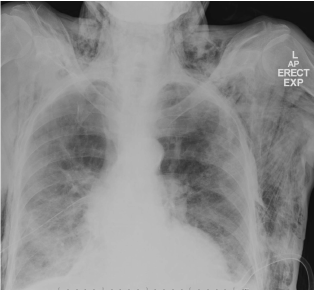| As far as emergency bleeps go, a patient with impending airway obstruction is one of my least favourite. This lack of enjoyment is augmented when it is the middle of the night and you’ve just made a nice cup of coffee. However, you can be sure that at least there will always be something that is interesting and challenging when you arrive. There was one such recent case that provided just such a management challenge by virtue of its novelty (at least for us) that threw up several learning points for those of us involved and which I hope might make interesting reading. As always with these things, many of the facts have been adjusted (and stuff completely made up) for patient anonymity, but I think the learning points remain intact. |
The Case
On our arrival the situation wasn't quite as bad as we feared. The patient was very much controlling their own airway and, though there was a definite hoarseness to her voice, there was no stridor, no features of respiratory distress and the rest of B, C, D and E were more than satisfactory. The extent of the subcutaneous emphysema was even more marked than anticipated however. There was major swelling of the patient's neck, face, eyelids and chest wall, to the extent that eye opening was difficult.
So, what to do now? Previously I've always seen surgical emphysema as more of a cosmetic nuisance type side effect of certain procedures and something that would be left to settles spontaneously once the initial problem was corrected. But as for a definitive management when the problem was an imminent threat to life, we didn't really know what the options were. Similarly it was clear that pre-emptive measures that might be employed in other scenarios when there was the risk of imminent airway loss (e.g. smoke inhalation) was a bad idea here. If this had developed so quickly spontaneously, positive pressure ventilation was not the next best step.
Discussion
The Primary Problem
A quick consultation with Dr Google brought up handful of similar cases with a combination of airway, breathing and circulatory failure secondary to cases of 'tension subcutaneous emphysema'. Basically, the subcutaneous air reached such a pressure that it led to either airway oedema and obstruction, chest wall rigidity and ventilatory failure, or venous return obstruction with circulatory compromise. The options available therefore involved decompressing this tension, of which a few different approaches were described.
A subcutaneous drain is one such approach, and indeed is the approach that was advised over the phone by the cadiothoracic surgeons (unfortunately at a different hospital and dealing with bleeding aortas when we were asking for advice)(3,6). This approach makes sense when you draw parallels to a pneumothorax, basically allowing an escape route for all that compressed air to escape. The techniques described may be easy enough for those with surgical experience (what’s a fascia again?), but my first thoughts were that it sound rather challenging to insert a large bore chest drain into the correct space without a high margin for misplacement (though I suspect to volume of air there is likely to be pretty large in this scenario).
An alternative 'Blow Hole' approach (4,5) more closely mirrored the management of the tension pneumothorax, and seemed to me a more practical approach for the none-surgical trained anaesthetist in a bit of bother with an impending airway disaster. After a quick bit of local to the skin the authors described making decompression incisions bilaterally at a level 3cm below to midclavicular line. The incisions were 3 cm long and down to the level of the pectoral fascia (where you'd likely get a nice hiss of escaping air). They described it as simple, quick, and in a relative safe location for the novice in a bad situation. The results they described in their case series sounded very similar to the immediate improvement that you see with needle decompression of a tension pneumothorax and avoiding the intubation that was planned.
The Backup Plan
Final Thoughts
1. Watchful waiting was almost certainly a better option than pre-emptive intubation in this case give the patient’s stability and the risk of worsening things with PPV. Unless absolutely no choice, I’d try avoid the tube next time. This is quite different from other cases of an at risk airway (e.g. smoke inhalation).
2. If my hand was forced the described subclavicular decompression technique seems a relatively safe last throw of the dice to try and rescue an imminent airway/breathing/circulation failure if help can’t arrive in time. Using the relevant cardiothoracic or even ENT surgical help would be the ideal scenario if time permitted, but having a rescue technique in the back of my head feels comforting.
3. I think either an awake tracheostomy or fibre-optic intubation would be the most comfortable out of all the options available, though both of these would require a degree of time and therefore would probably come after the attempt at decompressing the neck.
Thanks for reading and I hope it was of interest. As always I’d love to hear your thoughts, especially if you have had the challenge of similar scenarios in the past as I think there is a wide scope for different approaches here which are worth discussing. I also recommend checking out the cases below if you haven’t already for some more detail on the topic.
BW
Tom Heaton
- Medscape - Air Leaks, Pneumothorax and Chest Drains
- Radiopaedia - Subcutaneous Emphysema
- Case Report; Subcutaneous Drain. Anaesthesia. 1995
- Case Report: Life Threatening Subcutaneous Emphysema. Anaesthesia. 2008
- 'Blow Holes' Management. Chest. 1992
- Case Report: Subcutaneous Drain. Respirology Case Reports. 2013
- Upper Airway Obstruction Case. BJA. 2004

 RSS Feed
RSS Feed
